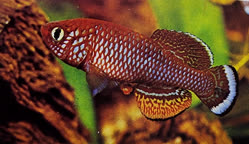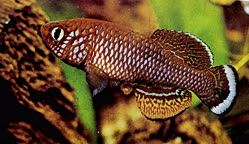|
|
As a child, there was one species of Nothobranchius killifish that fascinated me. At the time, it was named Nothobranchius brieni. Unfortunately, it existed in the hobby only in stunning photographs by the greatest tropical fish photographer to date - Arend van den Nieuwenhuizen. Nieuwenhuizen, also a fine breeder of many kinds of tropical fish but especially killies, had received eggs of what was identified then as N. brieni from friends in what was then the Belgium Congo. He hatched healthy fry and raised an aquarium strain in the early 1960's. From what I understand he lost this species without distributing it after one generation to an outbreak of Odinium in his tanks - a disease that particularly favors Nothobranchius species.
Nieuwenhuizen's surviving photos showed a gorgeous, intensely purple coloration to the males with a caudal fin sporting a pattern similar to N. rachovii and the photos were widely published in books in the 1970's. Soon after this supposed N. brieni appeared, the Belgium Congo exploded into anti-colonial violence and independence and the exportation of its Nothobranchius species ended for many years. This N. brieni became a legend. I believe a single specimen was again exported to Holland in the late 1970's and scientists realized that this N. brieni was not the true N. brieni but an undescribed species. Nieuwenhuizen's Notho. was finally named Nothobranchius polli. It should have been named N. nieuwenhuizeni. In the late 1970's, the country of Zambia, next to the area of the now free Congo where Congolese Nothobranchius are found (also the area of the Congo's great mineral wealth so very dangerous and violent!), began to be explored. The first Zambian Nothobranchius to be introduced to the hobby in the 1980's was soon named Nothobranchius kafuensis. When I first saw it I thought it was Nieuwenhuizen's N. polli as the two species are superficially similar in appearance. It turns out most of the Zambian - Congo Nothobranchius species are similar in appearance. Several locations of N. kafuensis soon graced the hobby (today, all seem to have disappeared from the US hobby even though N. kafuensis is easily bred). The next Zambian species to be widely distributed by the 1990's was the magnificent Nothobranchius symoensi. This fish when a young adult is for my money the most beautiful of all the gorgeous "Fire Killies" or Nothobranchius. Thanks to the efforts of Holger Hengstler, in 2008 or 2009, Nieuwenhuizen's N. polli was finally re-collected and re-introduced to the hobby. This location as well as several subsequent locations collected by Bela Nagy don't seem to be quite as colorful as Nieuwenhuizen's originals, based on their 1960's color photographs, but My experience may differ from many as I have always used slightly soft, slightly acid water for breeding these species, unlike with most other Nothobranchius. I started this when I was informed that N. symoensi was found in more forested areas in soft, neutral water. In slightly soft, acid water, N. symoensi was as easy as N. guentheri to breed. I did the same with N. polli andN. kafuensis. This is for breeding and then hatching only (for all 3 species I used a 3 months at room temperatures peat-coir storage time). Otherwise adults and growing fry - after conditioning them to the water chemistry change after hatching - were kept in slightly hard, alkaline water. Breeders were conditioned to the soft, acid water for breeding and then conditioned back to the harder more alkaline water after a week in the breeding tank over peat-coir. It is a lot of work but I believe it explains my success with Zambian-Congo Nothobranchius - along with generous feedings of live foods, especially live chopped blackworms. Nothobranchius have big appetites. Most breeders use hard alkaline water for East African Nothobranchius and those species are happy and prolific in such water. Zambian-Congo species are not. Using such water for breeding may explain why they quickly disappear from the US hobby. They need to be treated more like forest Aphyosemions, including temperatures only in the mid-70's - 74F-76F. Robert Ellermann, 2025
|






